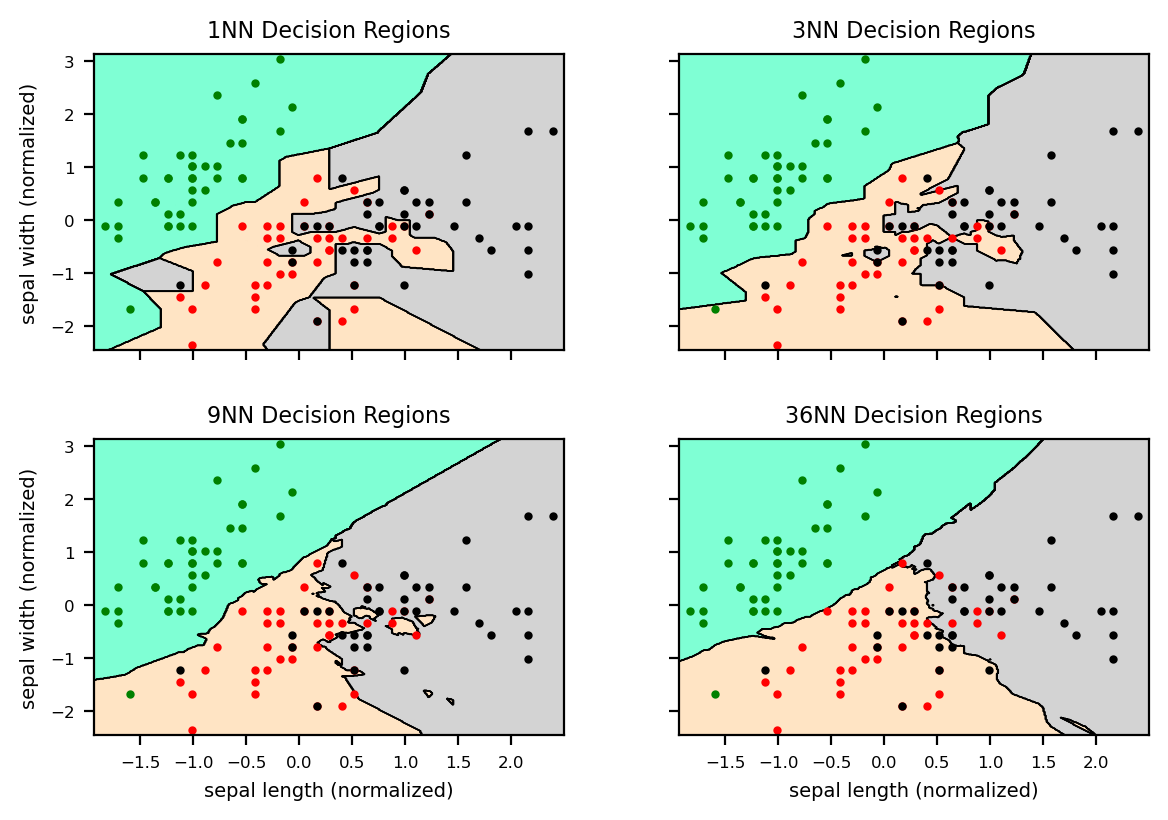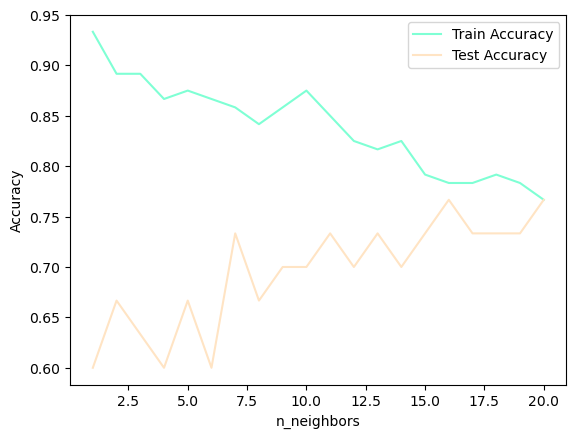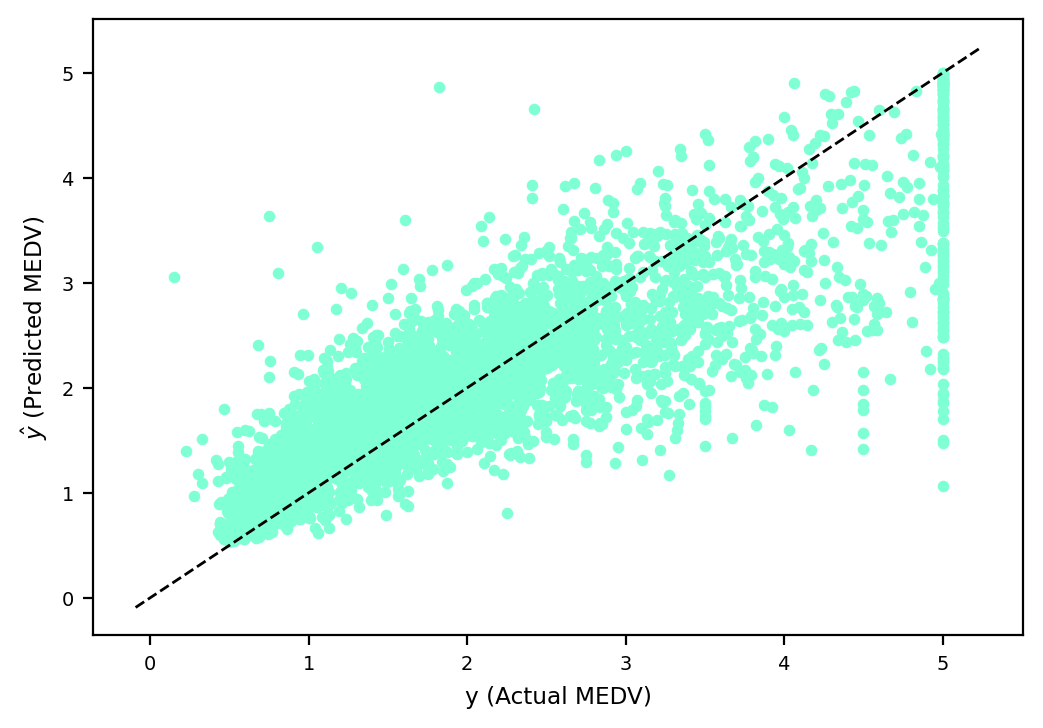import numpy as np
import pandas as pd
import matplotlib.pyplot as plt
import seaborn as sns
import warnings
warnings.filterwarnings("ignore")k-Nearest Neighbors
Classification
kNN is one of the oldest rules with a simple working mechanism and has found many applications since its conception in 1951 (Fix and Hodges, 1951).To make a prediction for a new data point, the algorithm finds the closest data points in the training dataset —its “nearest neighbors.”
Standard kNN Classifier
Given a positive integer and a test observation , the kNN Classifier does the following:
- Identify the points in the training data that are closest to , represented by .
- Estimate Conditional Probability for class as the fraction of the points in whose response values equal to :
- kNN applies then Bayes rule and classifies the test observation to the class with the largest probability.
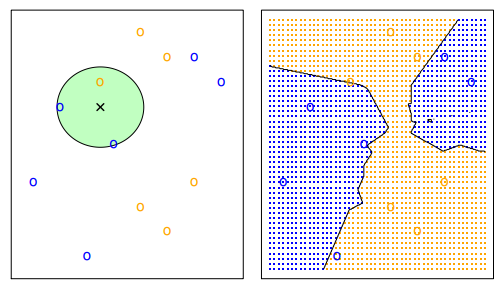
In binary classification applications, it is common to avoid an even k to prevent ties. It is common to see a kNN with k being 3 or 5; however, in general k should be treated as a hyperparameter and tuned via a model selection process (model selection will be discussed later).
In general, the larger k, the smoother are the decision boundaries. These are boundaries between decision regions.
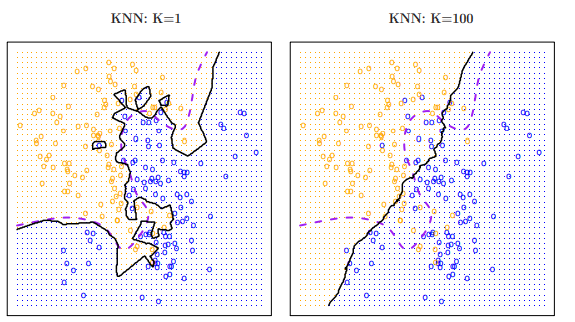
- For example, a is highly flexible (defined by ), classifying observations based off of the closest nearby training observation. This corresponds to a classifier that has low bias but very high variance.
- would do the opposite, basing its classification off a large pool of training observations. This corresponds to a low-variance but high-bias classifier.
The trade-off between flexibility, training error rate and test error rate applies to both classification and regression problems.
Model Training
In our previous section we have already seen how kNN classifier is used and implemented in scikit-learn. For illustration purposes, we only consider the first two features or columns in data. Here is the code again to train our model:
Code
from sklearn import datasets
iris = datasets.load_iris()
df = pd.DataFrame(iris.data, columns=iris.feature_names)
# Add target
df['target'] = iris.target
# Dictionary
target_names_dict = {0: 'setosa', 1: 'versicolor', 2: 'virginica'}
# Add the target names column to the DataFrame
df['target_names'] = df['target'].map(target_names_dict)
df.head(5)from sklearn.model_selection import train_test_split
from sklearn.preprocessing import StandardScaler
from sklearn.neighbors import KNeighborsClassifier as kNN
# Target vs Inputs
X = df.drop(columns=["target", "target_names"]) # Covariates-Only
y = df["target"] # Target-Outcome
# Train vs Split
X_train, X_test, y_train, y_test = train_test_split(X, y, stratify=y, test_size=0.2, random_state=0)
# Normalization
scaler = StandardScaler()
X_train = scaler.fit_transform(X_train)
X_test = scaler.transform(X_test)
# 2 Features Only
X_train = X_train[:,[0,1]]
X_test = X_test[:,[0,1]]
# Instantiate Class into Object. Set Parameters
knn = kNN(n_neighbors=3)
# Train Model
knn.fit(X_train, y_train)
# Predict
y_test_pred = knn.predict(X_test)Recall that we can evaluate the models using the following options:
from sklearn.metrics import accuracy_score
# Accuracy_score
print( accuracy_score(y_test_pred, y_test) )
# .score
print( knn.score(X_test, y_test) ) 0.6333333333333333
0.6333333333333333The Choice of k
Here we examine the effect of k on the decision boundaries and accuracy of kNN on our Iris dataset. The following code produces the visualizations of the decision boundaries for k=1, k=3, k=9 and k=36 neighbors:
%matplotlib inline
import matplotlib.pyplot as plt
from matplotlib.colors import ListedColormap
from sklearn.neighbors import KNeighborsClassifier as kNN
color = ('aquamarine', 'bisque', 'lightgrey')
cmap = ListedColormap(color)
mins = X_train.min(axis=0)- 0.1
maxs = X_train.max(axis=0) + 0.1
x = np.arange(mins[0], maxs[0], 0.01)
y = np.arange(mins[1], maxs[1], 0.01)
X, Y = np.meshgrid(x, y)
coordinates = np.array([X.ravel(), Y.ravel()]).T
fig, axs = plt.subplots(2, 2, figsize=(6, 4), dpi = 200)
fig.tight_layout()
K_val = [1, 3, 9, 36]
for ax, K in zip(axs.ravel(), K_val):
knn = kNN(n_neighbors=K)
knn.fit(X_train, y_train)
Z = knn.predict(coordinates)
Z = Z.reshape(X.shape)
ax.tick_params(axis='both', labelsize=6)
ax.set_title(str(K) + 'NN Decision Regions', fontsize=8)
ax.pcolormesh(X, Y, Z, cmap = cmap, shading='nearest')
ax.contour(X ,Y, Z, colors='black', linewidths=0.5)
ax.plot(X_train[y_train==0, 0], X_train[y_train==0, 1],'g.', markersize=4)
ax.plot(X_train[y_train==1, 0], X_train[y_train==1, 1],'r.', markersize=4)
ax.plot(X_train[y_train==2, 0], X_train[y_train==2, 1],'k.', markersize=4)
ax.set_xlabel('sepal length (normalized)', fontsize=7)
ax.set_ylabel('sepal width (normalized)', fontsize=7)
print('The accuracy for K={} on the training data is {:.3f}'.format(K, knn.score(X_train, y_train)))
print('The accuracy for K={} on the test data is {:.3f}'.format(K,knn.score(X_test, y_test)))
for ax in axs.ravel():
ax.label_outer() The accuracy for K=1 on the training data is 0.933
The accuracy for K=1 on the test data is 0.600
The accuracy for K=3 on the training data is 0.892
The accuracy for K=3 on the test data is 0.633
The accuracy for K=9 on the training data is 0.858
The accuracy for K=9 on the test data is 0.700
The accuracy for K=36 on the training data is 0.817
The accuracy for K=36 on the test data is 0.733As we can see in Figure 1 , a larger value of the hyperparameter k generally leads to smoother decision boundaries. That being said, a smoother decision region does not necessarily mean a better classifier performance.
Let’s investigate whether we can confirm the connection between model complexity and generalization that we discussed earlier. We will we evaluate training and test set performance with different numbers of neighbors by creating the following loop:
training_accuracy = []
test_accuracy = []
# try n_neighbors from 1 to 20
neighbors_settings = range(1, 21)
for n_neighbors in neighbors_settings:
# Build
clf = kNN(n_neighbors=n_neighbors)
clf.fit(X_train, y_train)
# Score in Train
training_accuracy.append(clf.score(X_train, y_train))
# Score in Test
test_accuracy.append(clf.score(X_test, y_test))Code
# Setup
color = ('aquamarine', 'bisque', 'lightgrey')
# Plot
plt.plot(neighbors_settings, training_accuracy, label="Train Accuracy", color=color[0])
plt.plot(neighbors_settings, test_accuracy, label="Test Accuracy", color=color[1])
# Labels
plt.ylabel("Accuracy")
plt.xlabel("n_neighbors")
plt.legend()
# Show
plt.show()In Figure 2 we see that when more neighbors are considered, the model becomes simpler and the training accuracy drops. The test set accuracy for using a single neighbor is lower than when using more neighbors indicating that using the single nearest neighbor leads to a model that is too complex.
The Choice of Distance
To identify the nearest neighbors of an observation, there are various choices of distance metrics that can be used. Three popular choices of distances are Euclidean, Manhattan, and Minkowski.
In KNeighborsClassifier, the choice of distance is determined by the metric parameter. Although the default metric in KNeighborsClassifier is Minkowski, there is another parameter p, which determines the order of the Minkowski distance, and has a default value of . This means that the default metric of KNeighborsClassifier is indeed the Euclidean distance.
Regression
Standard kNN Regressor
The kNN regression method is closely related to the KNN classifier discussed in above. Given a value for and a prediction point , kNN regression first identifies the training observations that are closest to , represented by . It then estimates using the average of all the training responses in . In other words,
Here is written to emphasize that function is essentially an estimator of .
To examine the kNN functionality in regression, we will use another well-known dataset that suits regression applications.
California Housing dataset
Here we use the California Housing dataset, which includes the median house price (in $100,000) of 20,640 California districts with 8 features that can be used to predict the house price.
Code
from sklearn import datasets
california = datasets.fetch_california_housing()
df = pd.DataFrame(california.data, columns=california.feature_names)
# Add target
df['target'] = california.target
# Add the target names column to the DataFrame
df.head(5)| MedInc | HouseAge | AveRooms | AveBedrms | Population | AveOccup | Latitude | Longitude | target | |
|---|---|---|---|---|---|---|---|---|---|
| 0 | 8.3252 | 41.0 | 6.984127 | 1.023810 | 322.0 | 2.555556 | 37.88 | -122.23 | 4.526 |
| 1 | 8.3014 | 21.0 | 6.238137 | 0.971880 | 2401.0 | 2.109842 | 37.86 | -122.22 | 3.585 |
| 2 | 7.2574 | 52.0 | 8.288136 | 1.073446 | 496.0 | 2.802260 | 37.85 | -122.24 | 3.521 |
| 3 | 5.6431 | 52.0 | 5.817352 | 1.073059 | 558.0 | 2.547945 | 37.85 | -122.25 | 3.413 |
| 4 | 3.8462 | 52.0 | 6.281853 | 1.081081 | 565.0 | 2.181467 | 37.85 | -122.25 | 3.422 |
Model Training
Now we are in the position to train our model. The standard kNN regressor is implemented in in the KNeighborsRegressor class in the sklearn.neighbors module. We train a standard k=50. Here we do not stratify.
from sklearn.model_selection import train_test_split
from sklearn.preprocessing import StandardScaler
from sklearn.neighbors import KNeighborsRegressor as kNN
# Target vs Inputs
X = df.drop(columns=["target"]) # Covariates-Only
y = df["target"] # Target-Outcome
# Train vs Split
X_train, X_test, y_train, y_test = train_test_split(X, y, test_size=0.2, random_state=0)
# Normalization
scaler = StandardScaler()
X_train = scaler.fit_transform(X_train)
X_test = scaler.transform(X_test)
# 2 Features Only
# Instantiate Class into Object. Set Parameters
knn = kNN(n_neighbors=50)
# Train Model
knn.fit(X_train, y_train)
# Predict
y_test_pred = knn.predict(X_test)Code
# Setup
plt.figure(figsize=(6, 4), dpi = 200)
# Figures
plt.scatter(y_test, y_test_pred, color=color[0],s=10)
lim_left, lim_right = plt.xlim()
plt.plot([lim_left, lim_right], [lim_left, lim_right], '--k', linewidth=1)
# Label
plt.xlabel("y (Actual MEDV)", fontsize='small')
plt.ylabel("$\hat{y}$ (Predicted MEDV)", fontsize='small')
plt.tick_params(axis='both', labelsize=7)
# Show
plt.show()In Figure 3, we can see that, for example, when MEDV is lower than $100k, our model is generally overestimating the target; however, for large values of MEDV(e.g., around $500k), our model is underestimating the target.
Model Evaluation
As previously discussed, all classifiers in scikit-learn have a that given a test data and their labels, returns a measure of classifier performance. For regressors the default score method is the statistics, given by:
where RSS and TSS are short for Residual Sum of Squares and Total Sum of Squares, respectively.
print( 'The test R^2 is:', knn.score(X_test, y_test).round(2) )The test R^2 is: 0.68Alternatively, we can use the r2_score from sklearn.metrics. This compares the actual data vs predicted data:
from sklearn.metrics import r2_score, mean_squared_error
print( 'The test R^2 is:', r2_score(y_test, y_test_pred).round(2) )The test R^2 is: 0.68Other common score is the Mean Squared Error (MSE):
A small MSE indicates the predicted responses are very close to the true ones. To use this, we run the mean_squared_error function from sklearn.metrics:
print( 'The test MSE is:', mean_squared_error(y_test, y_test_pred).round(2) )The test MSE is: 0.42
